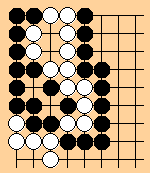
Some positions for a `Bestiary' of Go(Baduk, WeiQi)
Here are some notes that I got from from Matthew Macfadyen on 26-JAN-1996.
The position called `molasses ko' in the recent American Go Journal was actually described by Mark Hall in a BGJ a few years ago. It looks like this:

X is to play, and throws in to the 2 point eye. O had better take the ko (atari), X takes two stones (atari), O takes the second ko and then X can play one move elsewhere. If this is not a huge ko threat O will throw in to the 2 point eye and the position continues. The point about molasses is that something like a normal game can proceed at 20% of the usual pace on the rest of the board.
But the real fun begins if this position arises in a game played under a superko rule (no repetition of the whole board after any number of plays). Because in this case it is fatal to use your free move as a pass, and you suddenly find that the game has reverted to the primitive form of go in which passing constitutes a loss. The concept of territory is still there, but it can be worth quite a few points to play loose stones inside your opponent's territory. This is sometimes referred to as 'Conway Go' after J.H.Conway's work on games in which the loser is the first player unable to find a legal move.
Incidentally the bestiary should include this group
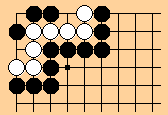
which is dead in Conway go (else X gets to play an infinite number of moves here), but also annoys various rule sets:
- With Chinese counting and a 'two passes ends the game' rule, and if the ko rule is worded carelessly, it is possible for X to play repeatedly in this area without losing points, thus winning on time or by waiting for the opponent to go to sleep.
- With a superko rule which does not regard passing as significant, and if the whole of the rest of the board consists of groups with exactly two eyes except that X has one ko threat; X can play the 1-3 point, O captures, X makes the ko threat, O answers, X retakes one stone, O has to pass (there's no other option by hypothesis). Now when X plays 1-3 again O can't capture because that would repeat the position.
And here's another beast which should be there:
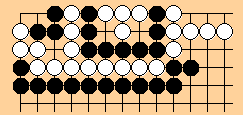
Things look good for O. In Japanese rules it's easy- X is dead and you can't fight ko in the analysis phase of the game. But such a position is likely to last all game- X will be trying to create a ko threat big enough to make the 1-1 point worthwhile, but O may well prevent this.
However, if O should actually try to take X off, he'd better start by adding a 5th stone to the nakade, X will capture and O will play at the centre. But now X has a nice ko threat to make two eyes.
I believe this position to be a seki if left to the end on most Chinese type rule sets, but to be a win for O in Japanese.
I also got another note from Matthew Macfadyen on 27-JAN-1996
Here's another beast (top left is a corner):

X has two interesting moves- the 1-1 point, which makes seki, and the 2-1 which makes ko (requiring X to find the first ko threat). But if X is behind on ko threats and fears that O will start the ko he had better play 1-1 to cool things down.
And having done that X still has the option to play 2-1 later, sacrificing 3 stones, and then start the ko.
Which brings up the topic of nonremovable ko threats. The obvious one is a seki, where your ko threat is self atari (which might be expensive) but do you know about this one? (the top left is a corner again):

This is a seki, albeit not a very plausible shape, and X has a ko threat which costs nothing and is not removable.
Irremovable ko threat : Martin Mueller
I got this from
From: mmueller@ICSI.Berkeley.EDU (Martin Mueller)
Here is another non point-losing irremovable Ko threat for you:
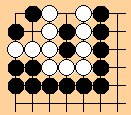
Top left corner of the board. W can capture two stones as a threat. Matthew's example is a bit nicer though, because in my example W eventually has to capture the stones.
I have slightly cleaned up the following message, which I have re-labelled, and which got from:
From: Nick@maproom.demon.co.uk
Subject: position for bestiary
on 22-APR-1996 10:29:45.97
Harry, Frank Janssen showed me this position yesterday:
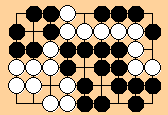
This is the whole of a 9*6 board. It is X's move. The superko rule is in use.
Common sense, and all other rulesets, suggest that O's upper group is alive. However under the superko rule X can kill it:

X plays `b' and says atari.
O plays `a', capturing two stones.
X plays `d' in the lower left corner, as a ko threat.
O answers at `c'.
X makes a record of the position (with X to play); and plays 2-1 in the upper right corner, capturing one stone (the one at `a').
O cannot play with putting himself in atari, and so passes.
X plays `b' and says atari. He reminds O that a play at `a' will repeat a previous position.
Nick
In the position shown above, you may ask why White has not already played at `c' (to remove the ko threat, before it can be used). Obviously White may not have had a chance to do so yet! Another possibility is that the scoring is only of empty points and prisoners (rather than of both stones and territory), and that if White played there (given the particular number of prisoners, and the size of `komi') they would lose anyway.
It is possible to construct a more `credible'/general problem with a slightly bigger board. One could make a ko-threat (against White) which could not be extinguished --- you can simply have a `seki' which Black would deliberately throw away, gaining the White group in the top right as compensation.